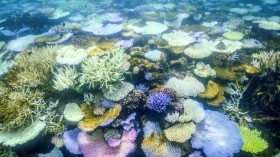Engineers from Duke University, in collaboration with the optoelectronic materials company SRICO, have developed a new kind of sensor that's capable of detecting invisible infrared signatures emitted by various kinds of gases, plastics and other sources.
The new sensor, described in a paper published in the journal Optica, relies on the so-called metamaterials-engineered structures made of carefully designed repeating cells that are capable of interacting with electromagnetic waves in unnatural ways.
"The benefit of using metamaterials is that different components required in a detector can be combined into one feature," said Willie Padilla, professor of electrical and computer engineering at Duke, in a press release. "That simplification gains you a lot of efficiency."
For the prototype device, engineers at SRICO first peeled a 600-nanometer-thick slice of lithium niobate crystal, which is pyroelectric that creates electrical charges when it gets hot. The researchers then put a pattern of gold on top of the crystal slice. They tailored the gold layer into a pattern that combines the properties of the crystal to cause the pixel to absorb only a specific range of electromagnetic frequencies. By doing so, the light will not simply travel through the crystal without being absorbed.
The researchers observed that when the crystal generates electrical charges, the gold does double duty by carrying the signal to the detector's amplifier, eliminating the need for separate electrical leads.
The mechanism behind the new sensor could be used in many ways. The researchers noted that the design of their sensors could allow the device to be 10 to 100 times faster than existing detectors because the heat is created directly by the crystal.
By simply redesigning the details of the gold pattern, the researchers can fabricate the device to detect any specific range of electromagnetic frequencies. With this power, the device is capable of actively scanning areas for methane or natural gas leak, monitor the health of vast fields of crops and quickly sort out plastics for recycling.
© 2024 NatureWorldNews.com All rights reserved. Do not reproduce without permission.

![Microplastics Escape Body's Gut to 'Infiltrate' the Brain, Kidneys and Liver [Study]](https://1471793142.rsc.cdn77.org/data/thumbs/full/70195/280/157/50/40/microplastics-escape-bodys-gut-to-infiltrate-the-brain-kidneys-and-liver-study.jpg)



